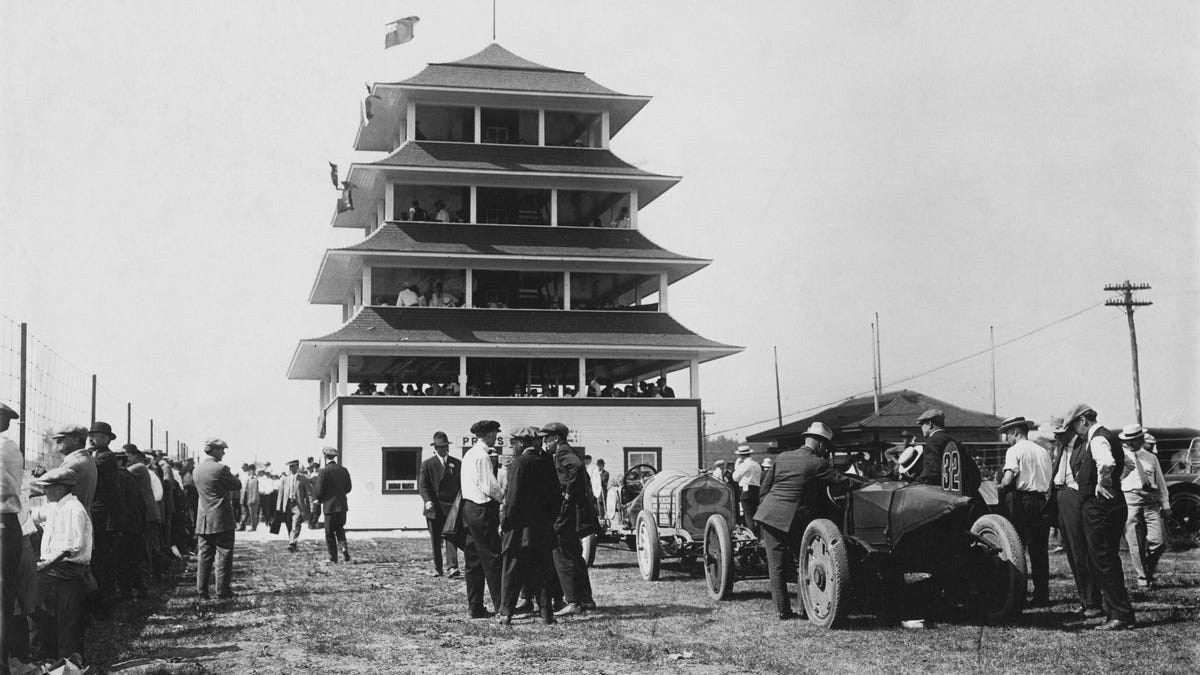Speedway, Indiana: 1912's Walled City of our Car-Centric Future

The Indianapolis Motor Speedway Pagoda c. 1913Photo: Topical Press/Hulton Archive (Getty Images)
Tomorrow’s Indianapolis 500 isn’t going to be held in the city of Indianapolis, Indiana. The iconic 500-mile race has never been run in Indiana’s state capital. The Indianapolis Motor Speedway is located in Speedway, Indiana, a small incorporated town surrounded by Indianapolis. It is racing’s equivalent of the Las Vegas Strip not actually being in Las Vegas, Nevada. Like how Paradise, Nevada exists to further the interests of the casino industry, Speedway was created to further the interests of the automotive industry.
Three years after the construction of the Indianapolis Motor Speedway, two of the track’s founders realized their dream of building a utopic city devoted to the automobile. Carl G. Fisher and James A. Allison purchased over 1,000 acres on the racetrack’s doorstep, laid out an entire planned city and began construction on the massive project by 1912.
The pits during 1911 Indianapolis 500Photo: Nathan Lazarnick/Hulton Archive (Getty Images)
Speedway’s founding fathers had the grand ambition of the planned city usurping Detroit as the capital of America’s then-fledgling automobile industry. Speedway planned to be legally distinct from Indianapolis because the enclave wanted to install its own government and make its own laws. The municipal government would only consist of employees of the automakers that built factories in Speedway. No other industry was allowed to set up shop in the new city.
The most strictly enforced regulation was that no horses would be allowed in Speedway, Indiana. An article about the planned city in a June 1912 issue of Motor Age noted:
“The city will be surrounded by a cement wall with artistic gates at the entrances. It will be, probably, the only city in the United States entirely surrounded by walls the old Chinese and Roman idea. These gates will be attended by liveried employees of the city, whose duty, largely, will be to see that the rule prohibiting the entrance of any horse into Speedway is not violated.”
G/O Media may get a commission
In the early 1910s, last-mile logistics had not yet been wholly motorized. Two different railroads built spurs into Speedway to facilitate shipping, and the city’s businesses would be forced by law to use trucks to move goods and materials from and to the freight depots. While Fisher’s and Allison’s vision of motor vehicles becoming the dominant form of transportation in the United States was correct, Speedway just wasn’t properly planned to accommodate it.
Ford’s River Rouge Complex c. 1946Photo: AFP (Getty Images)
Land was the most significant factor around Speedway’s ultimate failure. When Speedway’s 1st 1,000 acres were acquired, the 235-acre Buick City plant in Flint, Michigan was the largest automobile plant in the world. By 1928, Ford had opened River Rouge, which was nearly 1,000 acres on its own. Speedway simply underestimated how quickly the car industry was growing. There was no realistic way a major automaker could have mass-produced vehicles in the town. Not to mention that Indianapolis would envelop the purpose-built settlement in a few decades.
However, Speedway still remains an independent town of nearly 14,000 residents with its own municipal government, emergency services and school system. Wonder if horses are still banned.



